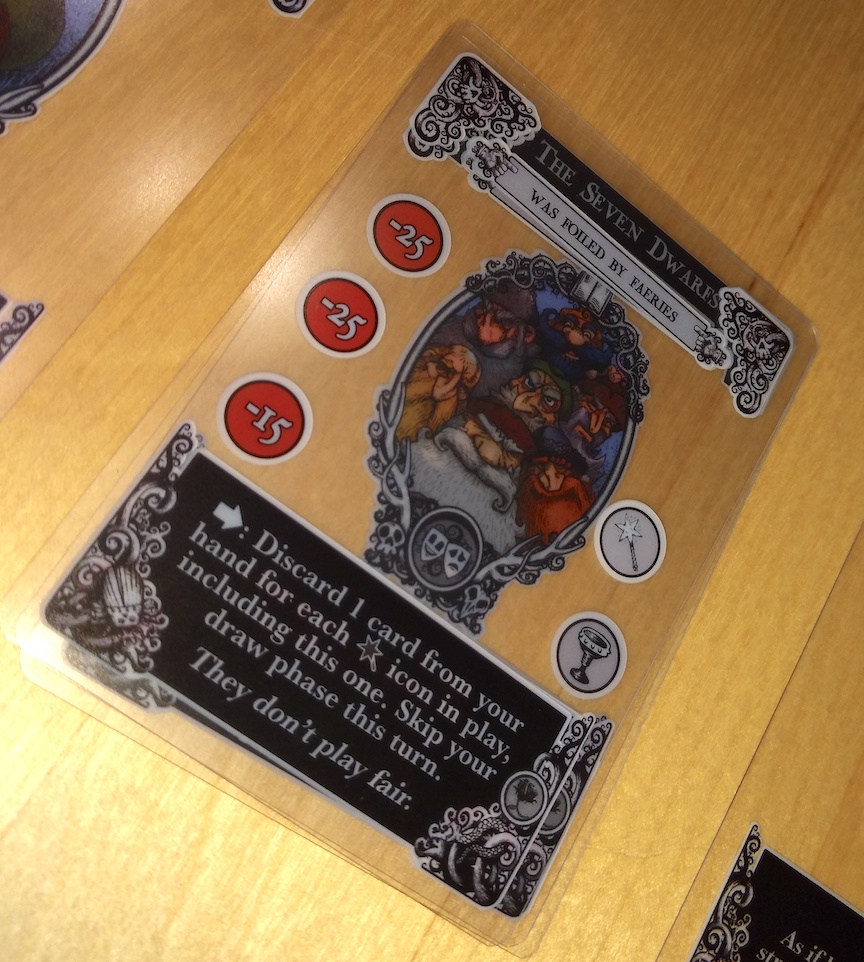We tried to make our family of misfit fantasy characters miserable before killing them off in Fairytale Gloom, the next game in our A-Z game shelf play-through.
 Basic Info: Fairytale Gloom
Basic Info: Fairytale Gloom
Players: 2-5
Time: 30-60 Minutes
Designers: Keith Baker
Artists: Jaume Fabregat
Publisher: Atlas Games
Fairytale Gloom is a story-telling card game where players manage a family of random fairytale characters. The goal is to make your own family as miserable as possible and then kill them off…er…give their story an untimely ending. At the same time, you’re trying to make your opponent’s family members happy by giving them good experiences. The game ends when one family entire family has been taken out. The player with the least points wins.

Each player starts with a family of four characters and a hand of five cards. There are also two “story” cards up for grabs that give bonuses and can be taken with the right symbols in your family.
On each player’s turn they do two actions including playing a modifier card on anyone’s unfinished character to change a character’s self-worth, playing an event card, playing an untimely death card (but only as your first action on your turn and only on characters with negative self worth), claiming a story card, discarding your entire hand, or passing. Then they draw back up to their card limit.

The cards are clear, literally clear, which allows for a lot of shifting in the game. The modifier cards have three places where negative or positive self-worth appear, and only the ones that show through at any given time count. So there’s a push-pull between playing your own negative modifiers on your characters, playing positive ones on your opponents to cover up their best negative self-worths, and then covering up the positive things that get placed on your characters.
In addition to the self-worth, the modifier cards have symbols that can give bonuses or penalties for various modifiers, events, or story cards. These also can be covered up by playing other modifiers. Finally, there are often other effects on the modifiers, which happen to the player whose character the modifier is played on. This can be increasing or decreasing your hand limit, stealing cards from a neighbor, or skipping your draw phase.

Once a player has an ending, no more modifiers can be added (except for various events and modifier effects). And once one player has provided endings for their entire family, the game ends. Players tally up the points on their finished characters and from their story cards, and whoever has the lowest overall self-worth wins.

I really like this game, even though there’s a fair amount of “take that”, since you *have* to mess with other players or you’re going to lose. However, modifiers that mess with other players typically give a decent reward, like upping their card limit or getting extra cards. At the same time, the best modifiers for your own family generally come with a penalty. So I feel like it balances out.
To me, a key part of the game is also the storytelling. You could play the game by simply laying cards on various characters, and not paying attention to the story you’re creating, but it would turn this into a very dry experience. Instead, it’s far more fun to recount the various things that are happening to the characters. “My Seven Dwarfs decided to cook Snow White a meal, but clearly had never been in the kitchen and found themselves stuck on a stove…all seven of them!”

How is it as a 2-player game? Fairytale Gloom works okay as a 2-player game, but I definitely prefer it at higher player counts. When it’s just two players, you only have one other player to mess with, but when there are more players, you can spread the joy, so to speak. There are also more opportunities to keep the game balanced with more players, since you’ll “gang up” on the player in the lead to make sure they don’t get too far ahead. And, in the 2-player game, it’s possible to have no cards in-hand to mess with your opponent, giving them a runaway win.
How about the art and component quality? The cards are brilliant – I love the clear card design with ways to cover up symbols and points. The art is great, and I love the flavor text on the cards. And clearly the game was designed by people with a love for fairy tales.
My one complaint is that the text is small and cramped. The symbols and self-worth points are easy enough, but for my aging eyes that additional text can be hard to make out.
Will this stay in my collection? Absolutely – I love the dark theme and it’s fun to pull out when I’m feeling a bit mischievous.

